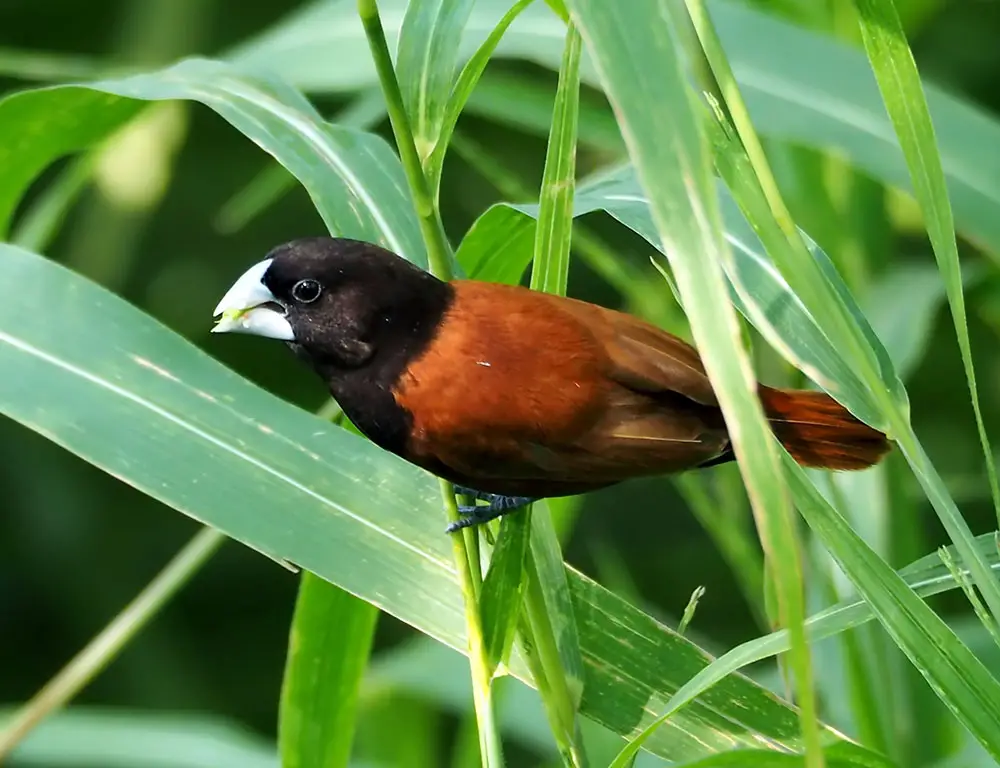The Chestnut Munia (Lonchura atricapilla), also known as the Black-headed Munia, is a small passerine bird species native to Asia.
With its striking plumage, social behavior, and adaptable nature, the Chestnut Munia has captured the interest of bird enthusiasts and researchers alike.
Found in various habitats ranging from grasslands to urban environments, this species exhibits fascinating behaviors such as cooperative foraging, melodious vocalizations, and monogamous breeding pairs.
As an essential seed disperser and a common sight in many Asian countries, the Chestnut Munia plays a significant ecological and cultural role.
Understanding its biology, behavior, and conservation status is essential for ensuring its continued presence in the diverse landscapes it inhabits.
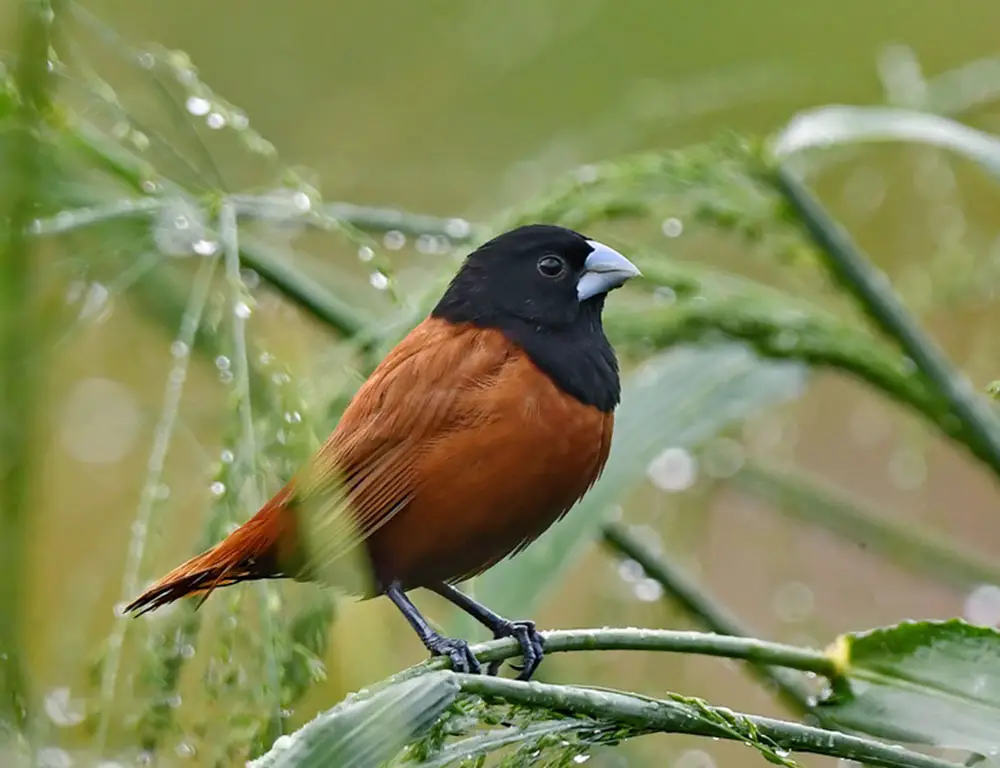
Unique Characteristics Of Chestnut Munia
The Chestnut Munia (Lonchura atricapilla), also known as the Black-headed Munia, is a small passerine bird species native to Asia. Here are some common characteristics associated with this species
Physical Characteristics
The Chestnut Munia (Lonchura atricapilla), also known as the Black-headed Munia or the Black-headed Nun, is a small passerine bird species native to Asia. Here are seven physical characteristics of the Chestnut Munia:
Plumage
The Chestnut Munia is characterized by its striking plumage, with chestnut-brown coloration on its upperparts and wings, contrasting with a black head and throat.
The underparts are typically white or pale gray, creating a distinctive and attractive appearance.
Head and Bill
As its name suggests, the Chestnut Munia has a black head that extends down to its throat and upper breast. Its bill is short and conical, adapted for cracking seeds and grains, constituting the bulk of its diet.
Size
The Chestnut Munia is a small bird, measuring approximately 10 to 11 centimeters in length, with a wingspan of around 15 to 16 centimeters. Despite its diminutive size, it is robust and agile in flight.
Tail
This species has a short tail, often held upright while perched. The tail feathers are typically dark brown or black, complementing the bird’s overall coloration.
Legs and Feet
The Chestnut Munia has slender legs and feet, well-suited for perching and hopping among vegetation. Its feet have sharp claws that aid in gripping branches and stems.
Sexual Dimorphism
Male and female Chestnut Munias exhibit similar plumage patterns, making them difficult to distinguish based on appearance alone. However, males may have slightly brighter and more intense coloration than females during the breeding season.
Distribution And Habitat
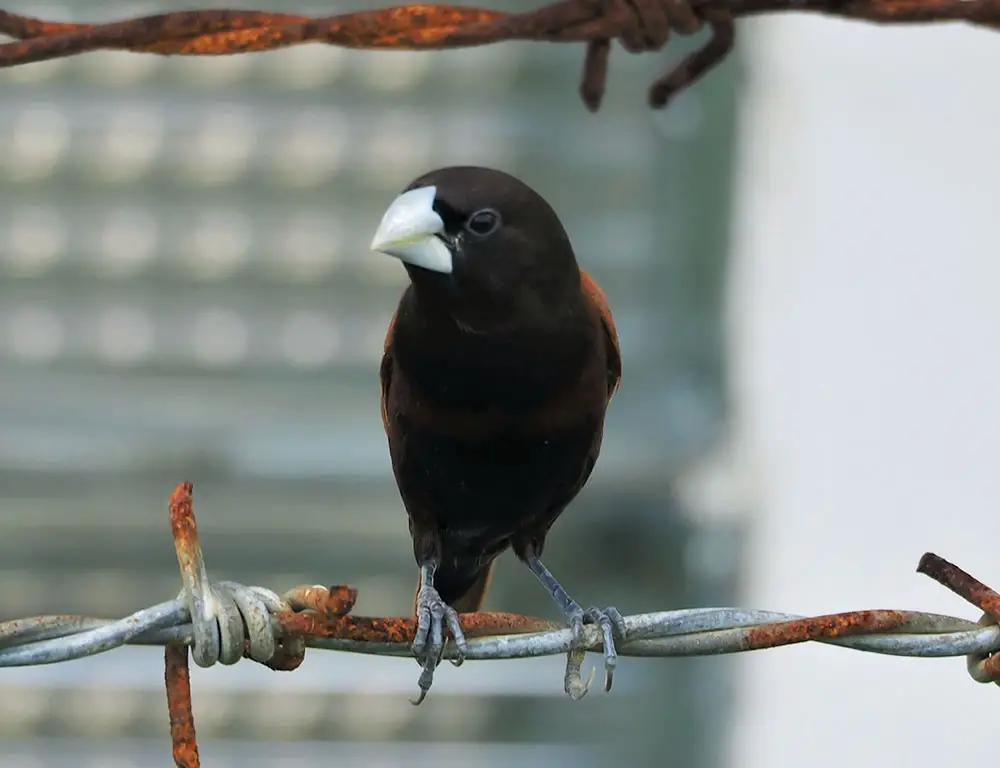
Chestnut Munias are widely distributed across Asia, inhabiting various habitats, including grasslands, agricultural areas, and open woodlands. They are commonly found in India, China, Indonesia, and the Philippines.
Subspecies
Several subspecies of the Chestnut Munia exist, varying in plumage coloration and distribution across their range. These subspecies may exhibit slight differences in appearance and behavior.
Behavior And Ecology
Chestnut Munias are social birds, often forming small flocks outside the breeding season. They feed primarily on seeds and grains, foraging on the ground or in low vegetation. Their presence is frequently marked by cheerful chirping and fluttering movements.
National Bird Of The Philippines Until 1995
The Chestnut Munia was designated as the national bird of the Philippines until 1995, when the Philippine Eagle replaced it. Despite this change, the Chestnut Munia remains an iconic and beloved bird in Filipino culture.
Call And Vocalization
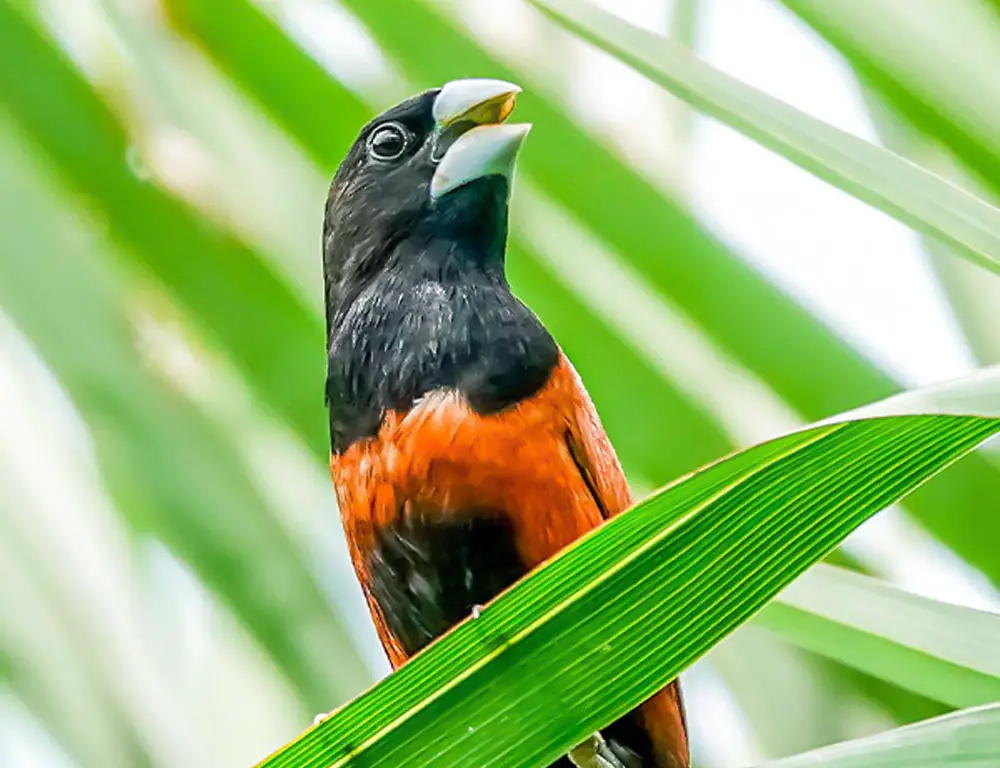
Chestnut Munias are known for their musical and repetitive calls, which vary in pitch and intensity depending on the situation. These vocalizations affect communication within the flock and during courtship displays.
Breeding
During the breeding season, Chestnut Munias form monogamous pairs and construct cup-shaped nests from grass and other plant materials. Both parents participate in incubating the eggs and caring for the young chicks until they fledge.
Conservation Status
The Chestnut Munia is generally considered to be of least concern regarding conservation status, as it has a wide distribution and stable population.
However, habitat loss and fragmentation due to urbanization and agricultural expansion pose potential threats to localized populations.
Relationship With Humans
Chestnut Munias are often welcomed in human-inhabited areas due to their insect-eating habits, which help control pest populations. However, they may also be considered agricultural pests in some regions where they feed on crops.
Systematics And Evolution
The Chestnut Munia belongs to the family Estrildidae, which includes various species of finches and munias. Its evolutionary history and genetic relationships with other members of its family are subjects of ongoing research and study.
Taxonomy
Here’s a simplified table outlining the taxonomy and classification of the Chestnut Munia (Lonchura atricapilla):
| Taxonomy Level | Classification |
| Kingdom | Animalia |
| Phylum | Chordata |
| Class | Aves |
| Order | Passeriformes |
| Family | Estrildidae |
| Genus | Lonchura |
| Species | Lonchura atricapilla |
This classification reflects the evolutionary relationships and taxonomic placement of the Chestnut Munia within the animal kingdom, chordate phylum, aves class, passeriformes order, estrildidae family, Lonchura genus, and its specific species name, Lonchura atricapilla.
Nesting Habit
Here’s a simplified table outlining the nesting habits of the Chestnut Munia (Lonchura atricapilla):
| Nesting Habit | Description |
| Nest Type | The Chestnut Munia constructs cup-shaped nests of grass, fine twigs, and other plant materials, often lined with softer feathers or fur. |
| Nest Placement | Nests are typically situated in shrubs, bushes, or tall grasses, usually within proximity to a reliable food source and sheltered from predators. |
| Breeding Season | Chestnut Munias breed throughout the year, although peak breeding activity often occurs during the wet season when food availability is higher. |
| Clutch Size | A typical clutch consists of 4-6 eggs, although clutch size may vary depending on factors such as food availability and environmental conditions. |
| Incubation Period | Both male and female Chestnut Munias share incubation duties, with eggs hatching after approximately 12-14 days. |
| Parental Care | Both parents contribute to nest-building, incubating eggs, and caring for the hatchlings until they fledge and become independent. |
This table provides an overview of the nesting habits of the Chestnut Munia, including nest type, placement, breeding season, clutch size, incubation period, and parental care.
These nesting behaviors reflect the species’ reproductive strategies and adaptation to its habitat.
Ranging Map
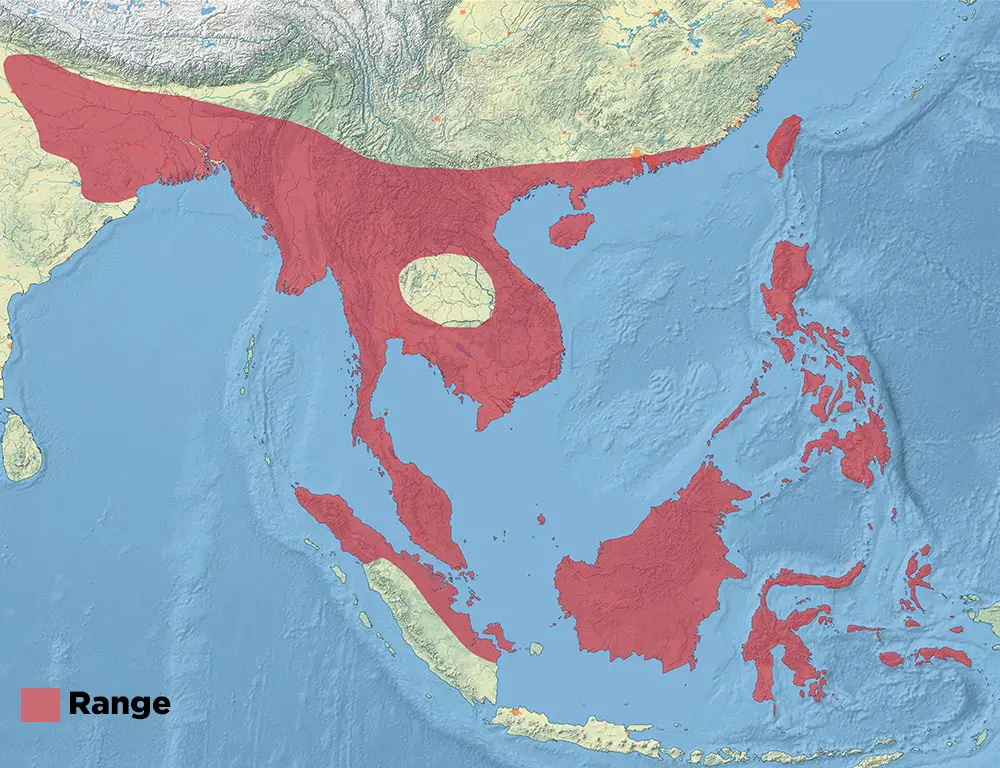
The Chestnut Munia (Lonchura atricapilla) is native to various regions across Asia, where it inhabits a wide range of habitats, including grasslands, agricultural areas, scrublands, and open woodlands.
Its distribution spans the Indian subcontinent through Southeast Asia and parts of East Asia.
In the Indian subcontinent, the Chestnut Munia can be found in India, Nepal, Bhutan, Bangladesh, and Sri Lanka, where it occupies diverse habitats ranging from grasslands and marshes to cultivated fields and urban areas.
In Southeast Asia, its range extends through Myanmar, Thailand, Laos, Cambodia, Vietnam, Malaysia, Singapore, and Indonesia, including the islands of Sumatra, Java, and Borneo.
It is also present in parts of East Asia, including southern China, Taiwan, and the Philippines.
What Are Some Common Diseases And Their Treatment Of A Chestnut Munia?
Chestnut Munias (Lonchura atricapilla) can be susceptible to various diseases, some of which may affect their health and well-being. Here are common diseases and their treatments:
Respiratory Infections
Symptoms include wheezing, nasal discharge, and labored breathing. Treatment involves providing a warm and dry environment and antibiotics prescribed by a veterinarian.
Parasitic Infestations
Parasites such as mites and lice can cause irritation and feather damage. Treatment involves using parasiticides a veterinarian recommends and maintaining good hygiene in the bird’s environment.
Nutritional Deficiencies
An inadequate diet can lead to deficiencies in essential nutrients like vitamins and minerals. Treatment includes supplementing the bird’s diet with appropriate nutrients and ensuring access to fresh food and clean water.
Avian Pox
Avian pox is a viral disease that causes wart-like growths on the skin and mucous membranes. Treatment involves supportive care and isolation from other birds to prevent spread.
Bacterial Infections
Bacterial infections can manifest as abscesses, septicemia, or enteritis. Treatment typically involves antibiotics prescribed by a veterinarian and supportive care to maintain hydration and nutrition.
Fungal Infections
Fungal infections such as aspergillosis can affect the respiratory system and cause respiratory distress. Treatment involves antifungal medication prescribed by a veterinarian and environmental modifications to reduce fungal spore exposure.
Egg Binding
Egg binding occurs when a female bird cannot pass an egg due to various factors.
Treatment may involve providing calcium supplements, warm baths, and gentle massage to help the bird expel the egg. In severe cases, veterinary intervention may be necessary to remove the egg surgically.
It’s essential to closely monitor Chestnut Munias’s health and seek veterinary care promptly if any signs of illness or distress are observed.
Proper husbandry practices, including a balanced diet, regular cleaning of the enclosure, and minimizing stress, can help prevent disease and promote overall health in captive birds.
Interesting Facts About Chestnut Munia
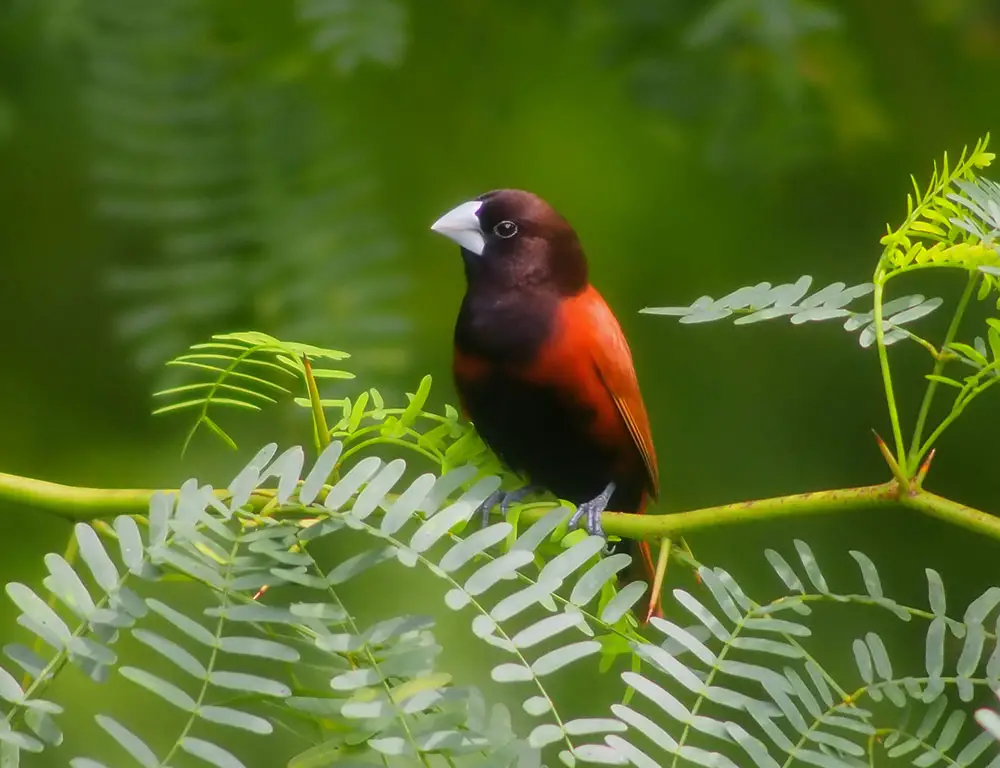
Here are some exciting Facts About Chestnut Munia:
Social Behavior
Chestnut Munias are highly social birds, often forming flocks outside the breeding season. These flocks may consist of several individuals and exhibit cooperative behaviors such as foraging and roosting together.
Vocal Abilities
Chestnut Munias are known for their musical and varied vocalizations, which include chirps, trills, and whistles. They use these vocalizations to communicate within the flock, during courtship displays, and establish territory.
Adaptability
Chestnut Munias are highly adaptable birds, capable of thriving in various habitats ranging from grasslands and agricultural areas to urban environments. Their ability to exploit various food sources and nesting sites contributes to their success in diverse landscapes.
Seed-Eating Diet
Chestnut Munias primarily feed on seeds and grains, although they may also consume small insects and plant matter. Their strong, conical bills are well-adapted for cracking open seeds, making them important seed dispersers in their ecosystems.
Breeding Behavior
During the breeding season, Chestnut Munias form monogamous pairs and construct cup-shaped nests from grass and other plant materials. Both parents participate in incubating the eggs and caring for the young chicks until they fledge.
Range Expansion
Chestnut Munias have expanded their range beyond their native habitat in Asia, with established populations found in regions such as Australia, Hawaii, and various islands in the Pacific.
These introduced populations may compete with native bird species for resources.
Cultural Significance
Chestnut Munias are kept as pets or showcased in aviaries in some cultures due to their attractive plumage and lively behavior. They are also featured in traditional art and literature, symbolizing beauty, freedom, and companionship.
FAQs
What does a Chestnut Munia eat?
Chestnut Munias primarily feed on seeds and grains, although they may also consume small insects and plant matter. Their strong, conical bills are well-suited for cracking open seeds, making them important seed dispersers in their ecosystems.
Where can I find Chestnut Munias?
Chestnut Munias are found in various habitats across Asia, including grasslands, agricultural areas, scrublands, and urban environments. They inhabit countries such as India, China, Indonesia, Thailand, and the Philippines.
Are Chestnut Munias social birds?
Yes, Chestnut Munias are highly social birds that often form flocks outside of the breeding season. These flocks may consist of several individuals and exhibit cooperative behaviors such as foraging and roosting together.
How do Chestnut Munias reproduce?
During the breeding season, Chestnut Munias form monogamous pairs and construct cup-shaped nests from grass and other plant materials. Both parents participate in incubating the eggs and caring for the young chicks until they fledge.
Are Chestnut Munias kept as pets?
Yes, Chestnut Munias are sometimes kept as pets or showcased in aviaries due to their attractive plumage and lively behavior. However, it’s essential to ensure that they are obtained from reputable sources and provided with proper care and enrichment to ensure their well-being.
Conclusion
The Chestnut Munia stands as a testament to the resilience and adaptability of avian species in the face of changing environments.
Its captivating plumage, social dynamics, and ecological significance highlight the importance of conserving its habitats and understanding its role in Asian ecosystems.
By appreciating and protecting the Chestnut Munia, we preserve a beautiful and charismatic bird species and contribute to the broader conservation efforts aimed at safeguarding biodiversity and maintaining the balance of our natural world.
